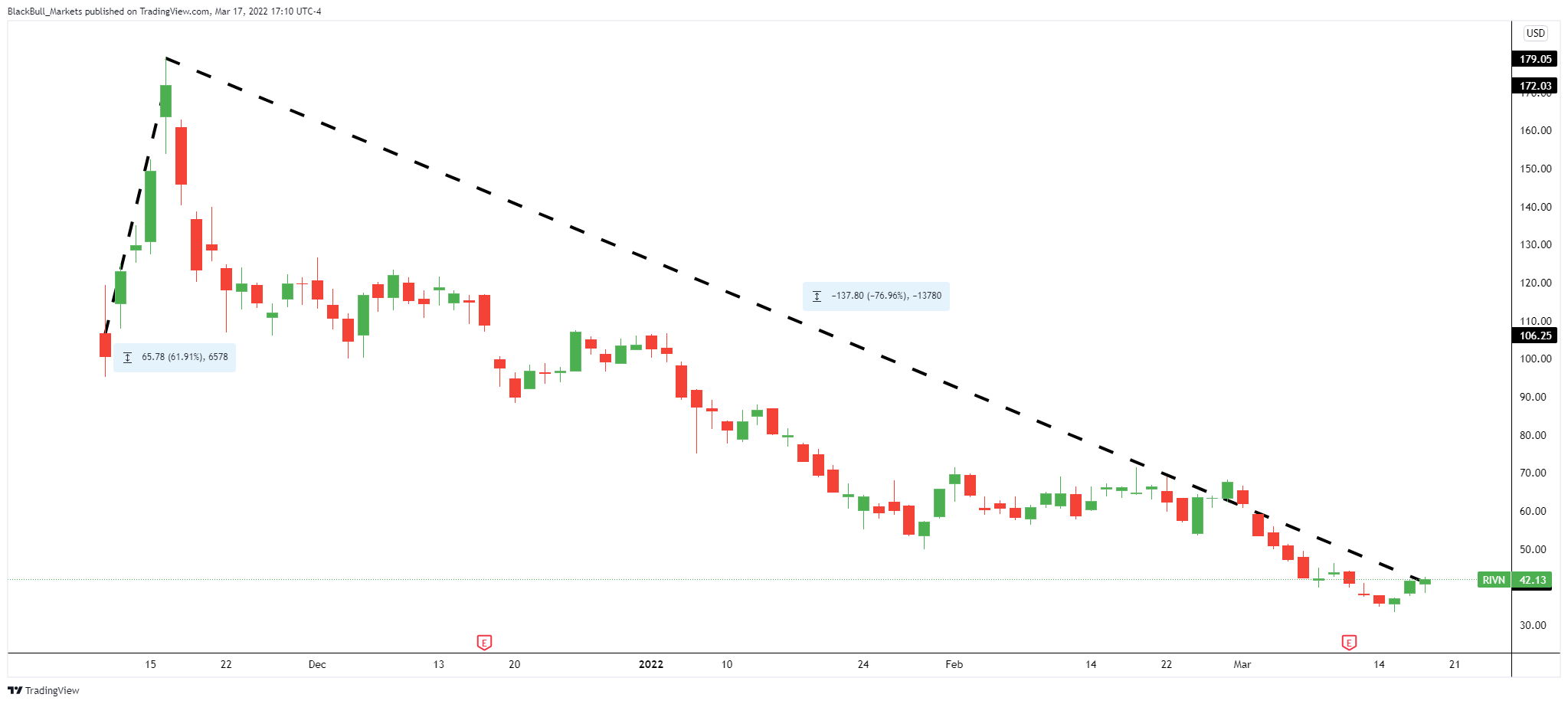Rivian Automotive (NASDAQ: RIVN), the budding electric vehicle maker, initially bank-rolled by the likes of Ford (NYSE: F) and Amazon (NASDAQ: AMZN), is currently trading 80% lower than its peak since listing on the Nasdaq stock exchange.
Bear in mind that Rivian was listed on the Nasdaq in November 2021, when you had to be very unlucky not to make money in the stock market, especially as a company working in the electric vehicle domain. In a sign of the jubilant (and bygone?) era, within days of listing, investor exuberance had pushed RIVN up by 115%, to US $170 per share. RIVN’s market electricity has fizzled in the following five months and could do with a recharge.
The Rivian stock price is currently trading very close to an all-time low, at US $37.00, 80% lower than its all-time high. In contrast, Tesla (NASDAQ: TSLA), a company which Rivian investors hope can be emulated, is trading 25% lower than its all-time high (US $1,200 vs US $900), which it reached in November 2021 (roughly the same time Rivian reached its all-time high).
RIV only just begun
As illustrated by its latest earnings call, Rivian has a momentous scope for growth.
In its Full Year 2021 earnings call, which was released on March 10, 2022, Rivian reported its first bout of revenue, a tiny US $55 million against a cost of revenue of US $520 million and other operating expenses (mainly R&D and administration) of US $3.7 billion. Consequently, Rivian reported a total net loss (inclusive of all costs) of US $4.7 billion for the full year.
The massive discrepancy between the company’s revenue and costs is a natural part of its growing pains. The automobile industry’s huge barrier to entry means that Rivian expects to be making a net loss for some time. However, it does expect to be profit-neutral by the end of the next financial year, and this might be what is more important for investors following the company.
No fast-charging solution
Rivian is still valued at over US $30 billion and far from a bust. However, it will perhaps take years for the company to charge its stock price back up to its IPO price of US $78.00. Even in the age of outsized valuations for EV companies and some residual investor exuberance in the market, investor confidence is butting up against obstacles such as the infamous chip-shortage affecting numerous car companies and tightening monetary policy from the US Federal Reserve.
To hasten the process and to overcome some of these obstacles on its way back to its IPO price, Rivian may have make better use of its US $18 billion cash reserve and carve out more than its planned 10% takeover of the EV market by 2030.
As it stands, Rivian’s total theoretical capacity at its two factories (600K) could garner 10% of the 2021 electric vehicle market. However, By 2030, electric vehicles sales are predicted to account for 1-in-2 vehicles sold, from a current 1-in-10. To account for 10% of all EVs sold in 2030, Rivian will have to boost production capacity to approximately 3 million vehicles per year.
For interest, Rivian generated its 2021 revenue of US $55 million on delivery of 2500 electric vehicles. The company’s guidance for 2022 expects to deliver 25K vehicles, which is a huge increase on its current production numbers, but fantastically far from the number of pre-orders on its books (83K) and unimaginably far from its 10% goal of 3 million.
Risk Warning: Trading foreign exchange on margin carries a high level of risk and may not be suitable for all investors. The high degree of leverage can work against you as well as for you. Before deciding to trade foreign exchange, you should carefully consider your investment objectives, level of experience, and risk appetite. The possibility exists that you could sustain a loss of some or all of your initial investment and, therefore, you should not invest money you cannot afford to lose. You should make yourself aware of all the risks associated with foreign exchange trading and seek advice from an independent financial adviser if you have any questions or concerns as to how a loss would affect your lifestyle.
Recommended content
Editors’ Picks

AUD/USD flirts with weekly high amid a bearish USD
AUD/USD scaled higher for the third straight day and retested the weekly top during the Asian session on Thursday. Concerns about a tariff-driven US economic slowdown, signs of a cooling labor market, and easing inflation give the Fed headroom to cut rates several times this year.

USD/JPY bulls seem reluctant amid divergent BoJ-Fed expectations
USD/JPY trades with a mild positive bias below the weekly high touched the previous day. A positive risk tone and concerns that Trump could impose fresh tariffs on Japan undermine the JPY. However, hawkish BoJ expectations keep JGBs elevated near a multi-year peak and should limit JPY losses.

Gold price moves within striking distance of record-high
Gold price climbed to over a two-week top during the Asian session on Thursday and might now aim to retest the all-time peak. Concerns about rising trade tensions and slowing economic growth underpin the safe-haven bullion.

XRP notes slight uptick following rumors of Ripple and SEC nearing a conclusion to their four-year legal battle
Ripple's XRP recorded a 2% gain on Wednesday following rumors of the company nearing an agreement with the Securities & Exchange Commission to end their four-year legal battle.

Gold price moves within striking distance of record-high
Gold price climbed to over a two-week top during the Asian session on Thursday and might now aim to retest the all-time peak. Concerns about rising trade tensions and slowing economic growth underpin the safe-haven bullion.

The Best brokers to trade EUR/USD
SPONSORED Discover the top brokers for trading EUR/USD in 2025. Our list features brokers with competitive spreads, fast execution, and powerful platforms. Whether you're a beginner or an expert, find the right partner to navigate the dynamic Forex market.
